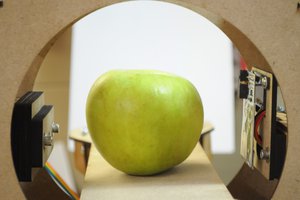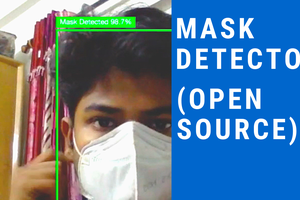The amount of radiation received from a point source follows the standard inverse square law of intensity:
This holds for any quantity that radiates isotropically away from the source, including gamma radiation.
Setup
An Am-241 source from a smoke detector is placed on a support to keep it level with the scintillator crystal of the Pomelo detector.

The number of counts in a 5 minute interval are recorded for several distances, as well as for the case where no source is present in order to account for background radiation levels.
Measurements
The detector recorded 5068 counts in 5 minutes with no source around. This number was subtracted from the number of counts recorded at every distance.

Counts (after background subtraction) vs distance from source
To verify the inverse square law people usually plot the number of counts vs 1/(distance^2). If that plot can be fitted with a straight line, then the measurements truly obey this law. Here is that plot for our numbers:

Counts vs the inverse square of the distance. Points lay nicely on a straight line
Conclusions
Using an Am-241 source and the Pomelo detector it's easy to show how the amount of radiation received decays as you go further away from the source. Doubling your distance decreases the radiation amount by a factor of 4. This is why it's safe to live with a smoke detector in your home. A fresh Am-241 smoke detector usually has an activity of 37 kBq, which at a distance of 1m is more than 1000 times lower than the background radiation.
 mihai.cuciuc
mihai.cuciuc
 peter jansen
peter jansen

 Jacob Joaquin
Jacob Joaquin
 satya sankar sahoo
satya sankar sahoo